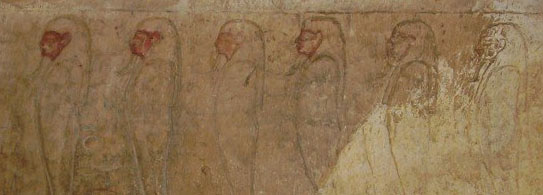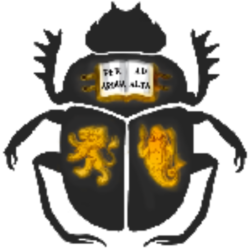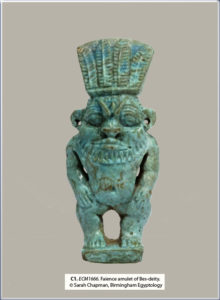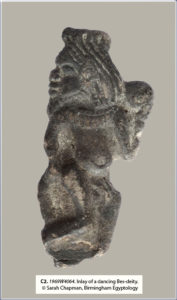Click the images to enlarge
——————————————————————————————————————————————————————————-
C. Object Labels (pdf file)
Click here for a 3D pdf model of C1. ECM1666 (pdf file)
 As implied previously, during the New Kingdom the Bes-image becomes more complex and changes within the iconography are more visibly dynamic. These changes begin with the introduction of amulets, small mobile items of material culture. Petrie recognized that Bes-amulets were used in Egypt from the Eighteenth Dynasty until the end of the Roman Period (Petrie 1914: 40) and they are among the most common objects found in Egyptological collections around the world. Romano has shown previously that during the reign of Amenhotep II the Bes-image becomes heavily anthropomorphised and the familiar dwarf characteristics of ‘Bes’ are introduced (Romano 1980: 44-46). Although many of the leonine features are retained, they become elements of a more noticeably human form – albeit one that has features common to stereotypical depictions of Nubians in Egyptian art. Zivie-Coche has previously discussed the introduction of Near Eastern deities into the Egyptian pantheon during the reign of Amenhotep II which coincides with the expansion of Egypt’s borders during the conquests of the Eighteenth Dynasty (Zivie-Coche 2011: 2-3). This ‘acculturation’ of deities is particularly prominent in iconography and reflects foreign deities being incorporated into the Egyptian cultural world view. Many of the deities discussed by Zivie-Coche had primary roles involving protection, something also common to the developing purpose of the Bes-deities (Zivie-Coche 2011: 1). Whilst Zivie-Coche did not discuss the introduction of Nubian deities, or indeed Nubian influence on Egyptian religion of the New Kingdom, it may be apparent during the New Kingdom development of Bes-deities that Nubian influence at this time may be responsible for some of the iconographic changes in the Bes-image, and subsequently the confusion regarding the origins of the god ‘Bes’ in modern scholarship (Graves 2012). ECM1666, although not dating from the New Kingdom period, exemplifies these iconographic introductions into the Bes-image during the Eighteenth Dynasty. The new dwarf-like character of the god is clear, yet the retention of the lion mane and lion tail on the reverse hearken back to the original leonine origins of the deity. The five fingered hands and five toed feet also indicate the anthropomorphic qualities now associated with the Bes-image. The facial features however betray a more stereotypically Nubian representation that is frequently depicted in Egyptian art. This shows Nubians as ethnically different, giving them flat noses, thick lips and occasional piercings. ECM1666 exhibits all of these features, including space for a nose piercing. The lines above the nose likely represent the snarl of the original lion iconography. The plumed headdress is also a new addition to the Bes-image during the New Kingdom and has previously been associated with the headdress of the goddess Anukis, who is also believed to have a Nubian connection (Bonnet 1952: 102).
As implied previously, during the New Kingdom the Bes-image becomes more complex and changes within the iconography are more visibly dynamic. These changes begin with the introduction of amulets, small mobile items of material culture. Petrie recognized that Bes-amulets were used in Egypt from the Eighteenth Dynasty until the end of the Roman Period (Petrie 1914: 40) and they are among the most common objects found in Egyptological collections around the world. Romano has shown previously that during the reign of Amenhotep II the Bes-image becomes heavily anthropomorphised and the familiar dwarf characteristics of ‘Bes’ are introduced (Romano 1980: 44-46). Although many of the leonine features are retained, they become elements of a more noticeably human form – albeit one that has features common to stereotypical depictions of Nubians in Egyptian art. Zivie-Coche has previously discussed the introduction of Near Eastern deities into the Egyptian pantheon during the reign of Amenhotep II which coincides with the expansion of Egypt’s borders during the conquests of the Eighteenth Dynasty (Zivie-Coche 2011: 2-3). This ‘acculturation’ of deities is particularly prominent in iconography and reflects foreign deities being incorporated into the Egyptian cultural world view. Many of the deities discussed by Zivie-Coche had primary roles involving protection, something also common to the developing purpose of the Bes-deities (Zivie-Coche 2011: 1). Whilst Zivie-Coche did not discuss the introduction of Nubian deities, or indeed Nubian influence on Egyptian religion of the New Kingdom, it may be apparent during the New Kingdom development of Bes-deities that Nubian influence at this time may be responsible for some of the iconographic changes in the Bes-image, and subsequently the confusion regarding the origins of the god ‘Bes’ in modern scholarship (Graves 2012). ECM1666, although not dating from the New Kingdom period, exemplifies these iconographic introductions into the Bes-image during the Eighteenth Dynasty. The new dwarf-like character of the god is clear, yet the retention of the lion mane and lion tail on the reverse hearken back to the original leonine origins of the deity. The five fingered hands and five toed feet also indicate the anthropomorphic qualities now associated with the Bes-image. The facial features however betray a more stereotypically Nubian representation that is frequently depicted in Egyptian art. This shows Nubians as ethnically different, giving them flat noses, thick lips and occasional piercings. ECM1666 exhibits all of these features, including space for a nose piercing. The lines above the nose likely represent the snarl of the original lion iconography. The plumed headdress is also a new addition to the Bes-image during the New Kingdom and has previously been associated with the headdress of the goddess Anukis, who is also believed to have a Nubian connection (Bonnet 1952: 102).

Another symbolic element introduced into Bes-image iconography during the New Kingdom is that of the musician (Petrie amulet type 189B, 1914: 41). In this role the god is frequently shown in profile, as opposed to his usual frontal face view, playing a drum- or tambourine-type instrument (Andrews 1994: 39; Dasen 1993: 59) as can be seen in 1969W4064. Here, the Bes-deity is shown striding forward with his left leg holding a round instrument in his left hand. The dynamism in this small inlay may indicate that the god is also dancing, while he appears to hold the lion tail that trail behind him. It is unclear why the god is at this time associated with music and dance, but one theory may indicate that the noise from this event would drive away evil from the home (Simmance 2012). The imagery shown in this example may represent an ancient household ritual to keep away evil from the home and may, therefore provide some explanation as to why Bes-masks have been found from as early as the Middle Kingdom.
 It is clear from the prevalence of surviving artefacts depicting the Bes-image that the deities were very popular during the New Kingdom, across all levels of society. Items found in the burial of Tutankhamun also preserve images of the god – one particular example still exhibits leonine symbolism (Carter Object No. 579). This is a calcite unguent vessel in the design of a standing lion topped with a plumed headdress. It rests one paw on a sA symbol, associated with protection, while it sticks out its tongue, a gesture that is also associated with protection as its aggressive stance was used to scare away evil from the object’s user (Millward 2012). This gesture is common in Bes-images during the Third Intermediate Period as will be discussed below.
It is clear from the prevalence of surviving artefacts depicting the Bes-image that the deities were very popular during the New Kingdom, across all levels of society. Items found in the burial of Tutankhamun also preserve images of the god – one particular example still exhibits leonine symbolism (Carter Object No. 579). This is a calcite unguent vessel in the design of a standing lion topped with a plumed headdress. It rests one paw on a sA symbol, associated with protection, while it sticks out its tongue, a gesture that is also associated with protection as its aggressive stance was used to scare away evil from the object’s user (Millward 2012). This gesture is common in Bes-images during the Third Intermediate Period as will be discussed below.


